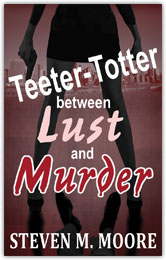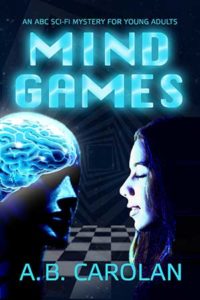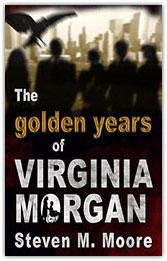Writing mysteries and crime stories…
The beginning: a crime is committed. The end: a crime is solved. Fill in the details.

This, of course, is an extreme case of simplification, where the Devil really is in the details. I knew that before I wrote my first mystery, Teeter-Totter between Lust and Murder in the “Detectives Chen and Castilblanco Series.” (Technically, The Secret Lab—see below—was the first one published, but that’s a YA sci-fi mystery.) You might have thought that The Midas Bomb, #1 in the detective series, was a mystery? Not in a pure sense; it’s a mystery/thriller, as many of those detective novels are. #2, Angels Need Not Apply, is almost a pure thriller. (I don’t see genres as hard boundaries, just key words to describe stories.) So when I had the idea for #3, I approached it with some trepidation.
I can’t remember if one of Christie’s novels or Asimov’s Caves of Steel was the first adult mystery I read. I say adult because I dived into that Hardy Boys series as soon as I learned to read, which occurred before the first grade, thanks to my mother. In any case, the samples in the mystery and crime genre that I’d read were numerous by the time #3 became a project, but I felt I still needed to learn more about writing in that genre before doing so. Responsible writers always have those doubts when tackling a new genre (I went through the same process with that YA novel).
I’m guessing they have a course on mystery writing in an MFA program—do they? No matter. At the time, there was plenty of available material about writing mystery and crime stories, some of it common to all genre fiction, other material delving into specific aspects—all “out there” and free. Here I’m not going to go into the various requirements for writing a mystery or crime novel. Those interested can find books and articles on the subject just like I did. But I have to confess, I learned more from osmosis. With a critical eye, I latched onto things I liked and rejected those I didn’t just from reading mystery and crime stories.
I’m going to go out on a limb here: Asimov, who had the benefit of following Christie, was better at mystery and crime writing than she was. I know…blasphemy! But that’s my opinion. Dame Agatha was an early pioneer although there were predecessors (Father Brown and Sherlock, for example) and well worth reading, but old Isaac knew all the devilish details required of a modern mystery or crime story. Besides the two robot mysteries Caves of Steel and The Naked Sun, he wrote many traditional mysteries. His Black Widowers stories are modeled after a club he belonged to, essentially a book club that studied mystery writing.
I took those two sci-fi mysteries featuring Earth detective Elijah Bailey and android Daneel Olivaw and compared them to Rankin’s Rebus oeuvre and James’s Dalgliesh, for example, and saw a lot of commonality. I doubt that Ian or P.D. ever read Isaac, but that doesn’t matter. Louise Penny and other writers also showed me how it’s done—things to emulate and things to avoid. All those mostly American writers of hard-boiled crime stories also taught me via osmosis.
I have no shame. I selected what I liked as a reader and emulated it as a writer, giving my own spin, of course. My characters are often a bit more diverse, my villains are often complex gals or guys, and my plots often contain uncomfortable and current themes as well as complexity—no cozy mysteries from me.
I’ve had a lot of fun following that winding path from the crime to its solution…and I will continue to do so. I love to read in this genre, and I will continue to write in it.

And, as a nod to Dr. Asimov, my alter-ego A. B. Carolan writes YA sci-fi mysteries. Perhaps they’re more related to those Hardy Boys stories; I’d like to think they’re what those YA novels should have been. (I’d have probably liked them a lot more!) But A. B. writes them with a twinkle in his eye, and you can see that same twinkle in every picture of Dr. Asimov.
Am I trying to upstage other writers? Nope. I just want to tell original stories mostly my own way, but, as Newton said, I stand on the shoulders of giants. I don’t think any of them will mind that.
***
Comments are always welcome.
Evergreen Bridges. What’s that mean? Many readers don’t realize that three of my series plus two bridge novels make one huge series. The Golden Years of Virginia Morgan provides a bridge between the “Detectives Chen and Castilblanco Series” and the “Clones and Mutants Trilogy,” while Soldiers of God provides one between the last series and the “Chaos Chronicles Trilogy” (now available as an inexpensive ebook bundle). Of course all these books are evergreen, as current today as when I wrote them…and you can read them in any order. They offer many hours of reading entertainment, from mystery and thrills to far-out sci-fi, and they are available wherever ebooks are sold.

Around the world and to the stars! In libris libertas!

December 12th, 2019 at 6:10 am
Steven,
You are certainly a prolific writer and a voracious reader. I always think of Asimov as a sci-fi writer and not a mystery writer. So you have informed me. I think we’ve all read Christie. Mystery and romance are my two preferred types of stories and novels. But I enjoy variety as you appear to do as well.
December 12th, 2019 at 12:10 pm
Jacqueline,
When Asimov’s oeuvre is examined, mysteries play a big part. So do popular science books. I’m not prolific compared to him, but I’ve always been an avid reader.
Have a great holiday season!
r/Steve